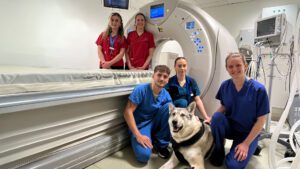Conclusion
This is the first report of 3-hydroxy-3-methylglutaric aciduria in the veterinary literature. The two cats from the same litter presented at 3–6 months of age with progressive spinocerebellar signs and weakness. The female cat developed cerebellar signs in the late stage of the disease and urinalysis revealed significant elevations in 3-hydroxy-3-methylglutaric acid. The cat was euthanased owing to deterioration. Histopathological examination of this cat revealed marked olivopontocerebellar degeneration. This case report highlights an organic aciduria as an important differential in a young cat presenting with progressive neurological signs. A diagnosis can be made at relatively low cost from urinalysis alone; however, the lengthy wait for results can be frustrating, especially if a patient is deteriorating. There is no specific treatment for 3-hydroxy-3-methylglutaric aciduria and the prognosis is grave.
Summary
A rescue charity-owned 6-month-old neutered female domestic shorthair cat was presented with progressive tetraparesis, increased extensor muscle tone and signs of spinocerebellar ataxia, including hypermetria. The cat’s male sibling, with similar progressive neurological signs, had been euthanased 2 months previously. An inherited metabolic disorder was suspected. Urine for determination of organic acid concentration was obtained and the cat was prescribed carnitine and taurine supplementation. The cat was euthanased 3 months later following progressive neurological signs, including ataxia, tetraparesis, tendency to fall, bilateral absent menace response and intention tremor. A selective post-mortem examination was obtained, taking samples from the brain, cervical spinal cord, tibial branch of the sciatic nerve, muscle, liver and kidneys. Organic acid analysis results received after euthanasia revealed a marked elevation of 3-hydroxy-3-methylglutaric acid (45 mmol/mol creatine [normal range 0–2]) and isovalerylglycine (27 mmol/mol creatinine [normal range 0–2]). 3-Hydroxy-3-methylglutaric acid was deemed clinically relevant as it is a metabolite of 3-hydroxy-3-methylglutaryl-CoA lyase, the enzyme involved in the final step of leucine degradation. Post-mortem examination revealed diffuse, chronic-active, severe olivoponto-(spino)-cerebellar degeneration.












